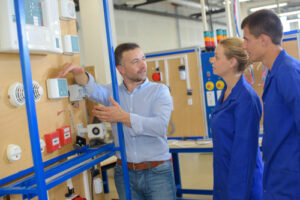 Jamie Allam, Commercial Director at Amthal Fire & Security, looks at the bigger picture of today’s workplace dynamics and shows how multi-generational collaboration is one way to bridge the skills gap and maintain a committed, competent workforce
Jamie Allam, Commercial Director at Amthal Fire & Security, looks at the bigger picture of today’s workplace dynamics and shows how multi-generational collaboration is one way to bridge the skills gap and maintain a committed, competent workforce
One guaranteed topic of conversation is the skills shortage in the industry. There simply aren’t enough qualified staff coming out of colleges and being trained in-house. Conversely, with engineers currently in the industry, they are either too multi-disciplined to specialise or struggling to keep up with the pace of technological change.
It’s fair to say the skills shortage facing the industry is at critical level, with a talent gap across a range of professions.
The biggest concern is a divided workforce, where each group contributes to the industry with differing, apparently opposing, skill sets. But when combined, they present a formidable force for any company that can achieve the necessary balance and maintain commitment across the board.
Generational differences
To achieve this, we need to understand more about the ‘divided workforce’, not only in their work place, but in their perspective and approach to work/life balance, method of communications and comfort levels with technology.
The new generation coming into the work place (Millennials and now Generation Z) are the connected generation, who live on their mobile phones and love the internet. They may have learnt the theory at higher education, and now expect a good work/life balance; often prepared to change jobs often to establish their lifestyle.
Where they lack experience and possibly skill sets (at the beginning), they make up for in latching on and understanding all things smart and digital; a clear winner for the technologies now entering the fire and security industry.
At the other end of the scale, the ‘Maturists’ have established skill sets and working patterns. They may have stayed within the industry, are fully trained, and developed a clear understanding of the intricate technicalities surrounding traditional fire and security solutions.
Their idea of working environment centres more around a ‘fixed workspace’ with a ‘defined’ role in which they are comfortable. And from this basis, knowledge and experience has been developed to become competent experts in their field, especially in our experience, with our skilled engineers.
But by their nature (and often admission) they are less likely to embrace modern technologies, even when it comes to personal communications. There is little ‘trust’ shown in smart fire and security solutions; whether it be for residential or commercial premises.
The third ‘group’ perspective (labelled Generation X and Y) are those that perhaps fit in the middle. On a personal level, they have witnessed the complex transition to mobile domination and in a working environment have felt the effects of creating successful ‘flexible working’ opportunities.
In the fire and security industry, they have been trained to operate traditional systems, but not to the extent of their seniors. At the same time have attempted to embrace new technologies, trying to become all-encompassing support and perhaps losing core skills in the process.
Embracing differences
The natural solution is to create an environment where the more traditional workers can embrace technology to benefit the business (and themselves.) But it’s also setting the scene for the new generations coming into the workforce to see the potential of a commitment to the sector.
Here, it’s up to company owners to set the standard with best work practices that meet these objectives. These include flexible working, open communications throughout a company (not being too email focussed), training opportunities and creating more focussed time for productivity and effective work without distraction.
The solutions that make the difference enable workplace flexibility, make the most of employees’ valuable work time without demanding stressful always-on availability, all without comprising competence or operational efficiency.
By example, carefully curated Apprenticeship schemes, is one development helping to encourage a workplace environment ripe for multi-generational collaboration, particularly because apprentices are ready to adopt new innovations, and embrace the smart technologies available quickly and efficiently.
In summary, the fire and security industry is a service business – and it is a highly competitive – so we’re only as good as the last customer’s experience.
To be successful, a skilled workforce is absolutely integral. Unlike other industries, being able to understand and apply the technical aspects of fire and security installation, whether traditional or encompassing latest smart solutions (or often a mixture of both) quickly and efficiently, is vital to success.
With this in mind, to overcome the skills shortage, it’s not just about looking within, but also thinking differently, understanding the bigger picture and starting to embrace the opportunities of multi-generational collaboration. Here lies the potential for a fresher industry wide working environment, with the necessary ability to achieve the requirements of today’s increasingly discerning customers.

